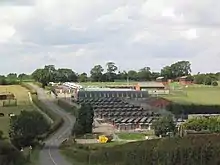Defence Animal Training Regiment
The Defence Animal Training Regiment (DATR) is a training establishment, based in Melton Mowbray, east Leicestershire. It trains animals, of which the most numerous are dogs, for all three armed forces. Its headquarters are also the principal base of the Royal Army Veterinary Corps.
| Defence Animal Training Regiment | |
|---|---|
 Defence Animal Training Regiment | |
| Active | 1946 - present |
| Country | |
| Type | Training |
| Role | Training for military veterinary staff, farriers, military working dogs, and horses |
| Garrison/HQ | Melton Mowbray, Leicestershire |
History
The Army first occupied the Melton Mowbray site in 1946, and it became known as the Defence Animal Centre, a title which remained current until 2018. RAF Police dogs began to be trained at the centre from 1994, after merging RAF and Army dog training in April 1991. The Army School of Equitation's indoor riding school was opened by Princess Anne on 28 February 2008.[1]
Regimental structure
The Defence Animal Training Regiment consists of three training squadrons and one training school.[2]
- Canine Training Squadron – the squadron trains 200 military working dogs per year for the British armed forces, and about 100 others for civilian border and security services, and foreign armed forces; it provides basic training for dog handlers; it also operates a canine veterinary hospital.
- Veterinary Training Squadron – the squadron provides specialist military training for personnel who are already qualified as civilian vets, usually for the first twelve months of their military service; the squadron also provides the primary health care for animals at the Melton Mowbray site.
- Equine Training Squadron – with stabling for 140 horses and grazing for 260 horses, the squadron provides training for all horses destined for the Household Cavalry (Life Guards and Blues and Royals) and for the King's Troop, Royal Horse Artillery; it also provides initial training for military horse riders and riding instructors.
- School of Farriery – the school is a centre of excellence in military farriery, and trains all of the British Army's farriers; it is officially recognised by the Worshipful Company of Farriers and the Farriers Registered Council.
Function
Organisation requirements

As well as British defence organisations, it prepares dogs for the UK Immigration Service, HM Prison Service, HM Revenue and Customs (former HM Customs and Excise), other UK government agencies and overseas agencies including the Irish Revenue Customs Service. UK police dogs are trained in-house at nine regional training centres, such as the Met's site at Keston and Scotland's centre at Pollok Country Park.[3]
Detection skills
The dogs, often Springer Spaniels, Labradors and Belgian Shepherds are mainly trained as detection dogs to detect drugs, bombs and ancillary parts. Substances the dogs are trained to detect include TNT, Cordtex, C-4 and Semtex.[4]
Supply of animals
It trains about 100-150 dogs a year, taking about four to six months to train. Some dogs are donated by the general public with the rest often purchased from both national and international vendors. The Services Veterinary Hospital looks after the health of all the dogs (Canine Training Squadron) and horses (Equine Training Squadron) of the UK armed forces (mainly the British Army). The site was used as a training ground for the London Olympics 2012 for cycling and equestrian events.[5]
In combat
In the field, some military (and police) dogs can be fitted with special bullet-proof vests to protect them.[6]
Army School of Farriery
At the Centre is a School of Farriery (training to repair horseshoes), recognised by the Worshipful Company of Farriers and Farriers Registered Council. International farrier competitions are held at the centre annually. 140 horses can be stabled at the centre, with 260 out at grass in 240 acres (0.97 km2) of grazing.[7]
References
- "Calendar of the British Royals (February 2008)". Archived from the original on 3 March 2016. Retrieved 15 April 2014.
- "Who we are: Defence Animal Training Regiment". Ministry of Defence. Retrieved 17 May 2019.
- "Pollok Country Park". Glasgow City Council. Retrieved 15 April 2014.
- "Bomb dogs". Archived from the original on 16 April 2014. Retrieved 15 April 2014.
- "Training camps of Leicester and Leicestershire" (PDF). Archived from the original (PDF) on 16 April 2014. Retrieved 15 April 2014.
- "Canine vests". Retrieved 15 April 2014.
- "England Farriery team has a new manager". Archived from the original on 20 October 2012. Retrieved 15 April 2014.